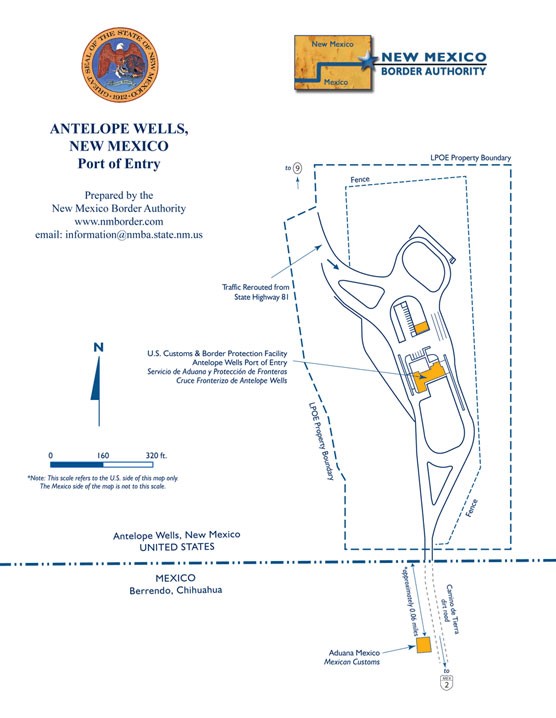Columbus
Modern! Convenient! Fast! Historic!
Bordering Palomas, Chihuahua and located within the historic Village of Columbus, New Mexico, the Columbus port of entry is approximately 30 miles south of Deming and 65 miles west of the Santa Teresa Port of Entry.
Open 24 hours a day, 7 days a week the Columbus port is New Mexico’s full-service port of entry. Bustling with activity and with many tourists and locals crossing daily, this recently remodeled POE remains a well-situated choice for travelers. Construction of an $80 million, new port of entry will start later in 2015 and be completed by 2018. The NMBA was instrumental in the construction of the $3.5 million bypass, the canopy to shade the tourists and the parking lot. Recently, NMBA committed $10,000 to the village of Columbus for infrastructure for a transportation study and $50,000 for a flood control feasibility study. Pedestrian walks and new infrastructure crossings are being proposed for the bordering town of Palomas, Chihuahua
Available Services at Columbus:
- Pedestrian Traffic
- Mexican Immigration Services
- U.S. Immigration Services
- Temporary Vehicle Export Permits
- Non-Commercial Traffic
- Commercial Traffic
- Livestock
- Custom Brokers
Traveling to Mexico
Palomas (pop. 5,000) is a popular tourist destination for tourists shopping for the many arts and crafts products unique to Mexico or in search of dental and optical services and pharmacies or simply seeking cultural exchange at the ever-popular “Tienda Rosa” restaurant. Visitors to Palomas can drive across the border or park for free in Columbus and walk to Palomas.
For travelers heading further into Mexico, such as to Ascension, Janos, Chihuahua City, or Casas Grandes, all necessary Mexican agencies are located at the Palomas port. It’s a one-stop location to obtain Mexican tourists visas, temporary vehicle permits, and other necessary travel documentation.
Traveling to the United States
Average northbound crossing time by car is 18 minutes and with short lines, walking is even quicker. Traffic into New Mexico is greatest during the months of December and July.
The quaint Village of Columbus (pop.1,700) is rich with border history. Visitors can stay overnight at a modern RV park, view exhibits about Pancho Villa’s 1916 raid and General Pershing’s subsequent military campaign at two museums, one which was converted from the turn of the century railroad station that served the border region. Be sure to visit Pancho Villa State Park while in Columbus. Columbus/Palomas is also the bi-national gateway for the Mimbres-Paquime Connection, a fascinating tourist route that showcases the shared natural and cultural resources of southwestern New Mexico and northwestern Chihuahua.
Here travelers can find food and refreshments before proceeding to the nearby cities of El Paso, Ciudad Juarez, Deming, Las Cruces, Silver City, other destinations in New Mexico and surrounding states.

Livestock
New Mexico hosts the largest and most efficient livestock import and export facilities on the Mexican border. Almost a third of all cattle imported each year from Mexico are processed at New Mexico ports. This year approximately three hundred thousand head of cattle will pass through the Santa Teresa and Columbus facilities.
Most cattle are feeder stock destined for pasture and feedlots in Texas, New Mexico, Arizona, California, and the Midwestern states. Even though most originate in Chihuahua, there is an increasing import trend from throughout Mexico. Horses and other livestock are also processed at New Mexico ports.
New Mexico livestock facilities offer practical and economic advantages over other border crossings. Livestock are penned and processed at the border, then walked into the US, saving time and transportation costs while minimizing weight loss. Elsewhere, livestock must be trucked between processing facilities on each side of the border increasing costs and adding stress to the animals.
First opened in 1991 and spanning the border approximately one mile east of the international port of entries, the Santa Teresa/Jeronimo livestock facilities are the most modern on the US/Mexico border with the capacity to process 5,000 livestock per day. At Columbus/Palomas port of entry, smaller facilities cater to the livestock producers of northwestern Mexico.
Union Ganadera Regional de Chihuahua operates both sides of the Santa Teresa/Jeronimo facilities as well as the Mexican facilities at Columbus/Palomas. The union is a cooperative comprised of livestock producers throughout Chihuahua and is well known throughout Mexico for its progressive marketing and processing initiatives. For more information go to Union Ganadera Regional de Chihuahua (in Spanish)
Procedures and Contacts for Livestock Crossings
Livestock imports and exports involve several Mexican and U.S. inspection agencies including:
- Customs and Border Protection
- Aduana Mexico
- U.S. Department of Agriculture
- U.S. Food and Drug Administration
- Mexican Secretaria de Agricultura, Livestock, Rural Development, and Fish (SAGARPA)
- New Mexico Livestock Board.
Customs brokers can provide valuable assistance in dealing with all the involved agencies. For additional information, in English and Spanish, concerning facilities, regulations, and procedures call the Union Ganadera Regional de Chihuahua at (575) 589-1620.
Livestock Trade Assistance
The New Mexico Department of Agriculture has a very successful marketing program for the export of breeding stock and other quality. For more information concerning the export program, contact Mr. David Lucero, Division Director with New Mexico state’s Department of Agriculture, Marketing and Development Division, at the following phone number: Office – (575) 646-4929, Fax – (575) 646-3303.
